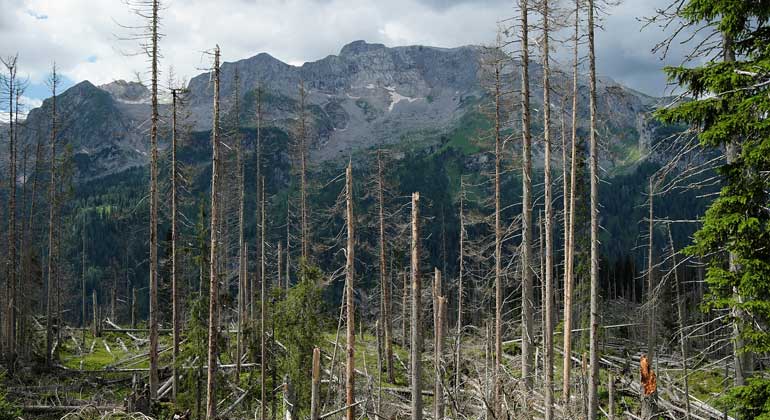First global climate risk map for forests
Study: Forests in central and western Europe face high climate risk
Climate change is putting increasing pressure on forests. In recent years substantial forest areas have died off in Central Europe as a result of climate extremes. With the participation of the Technical University of Munich (TUM), researchers have now generated the first climate risk map for the earth’s forests. The map clearly shows that, in addition to Central Europe, forests in western North America as well as the southern portion of the boreal forest and the eastern Amazon are particularly at risk.
Forests are often discussed as an important element in resolving the climate crisis due to their ability to absorb large volumes of carbon from the atmosphere and store it over long periods of time. But forests themselves are also greatly impacted by climate change. Changing climate conditions can weaken forests’ ability to absorb carbon, can change the tree species composition of forests and can result in large-scale forest dieback.
In the past the individual impacts of the climate on forests have been viewed in isolation. In a new study scientists have for the first time combined a range of risk factors to create a single global climate risk map for forests.
The global climate risk of forests
Researchers from seven institutions in Europe and the USA have combined previous findings on the global climate risk of forests.
They took three risk dimensions into account: First they used global vegetation models to assess the risk of a decrease in carbon storage by forests. Their analysis looked at how high the probability of carbon loss will be at the end of the century relative to today’s values. “The estimated risk of species loss was based on global species distribution models which calculate the distribution of species under a given set of climatic conditions,” says study co-author Rupert Seidl, Professor for Ecosystem Dynamics and Forest Management in Mountain Landscapes at TUM.
The scientists then took a closer look at the climate-related risk of disturbance, i.e. the probability of large-scale forest dieback, based on evaluations of global satellite data from recent years. “Each of these approaches has different strengths and weaknesses. But a combination of the various dimensions provides new insights into the global climate risk facing forests,” says University of Utah’s William Anderegg, lead author of the study.
Central European forests under pressure from climate change
Across all the risk factors analyzed, it was evident that forests in central and western Europe are subject to high levels of climate-related risk. “Here the probability of climate-related disturbances is high. Species that are currently important components of the system could disappear and the amount of carbon stored could be reduced. The analyses confirm regional observations made in recent years,” says Prof. Rupert Seidl. “This emphasizes the fact that our forests in central Europe are experiencing increasing pressure from climate change.” Other areas with high climate risk are the southern boreal forest, for example in Canada and Russia, as well as drier areas in the tropics such as the eastern Amazon.
Forest development under climate change remains uncertain
However, the study also shows that there are still great uncertainties relating to climate risk for forests. For each risk factor, the scientists investigated not only an individual model, but rather compared a number of approaches – often finding little agreement among the different approaches. In addition, divergences between individual risk factors emerged, pointing to uncertainties in the global development of forests in climate change and highlighting the need for further research.
“Our projections are only as good as the underlying models,” says Seidl. “We urgently need better data and experiments to make the models more robust.” Anderegg adds: “Specifically, climate-related disturbances and the subsequent recovery have to be better represented in forest models in order to reduce uncertainty in future forest developments.”
- William Anderegg, Chao Wu, Nezha Acil, Nuno Caravalhais, Thomas Pugh, Jon Sadler & Rupert Seidl: A climate risk analysis of Earth`s forests in the 21st century. In: Science. DOI: 10.1126/science.abp9723. Publication date: September 2, 2022
- The results of the study are available as dynamic online maps here








